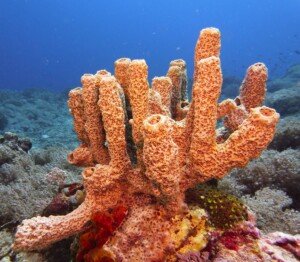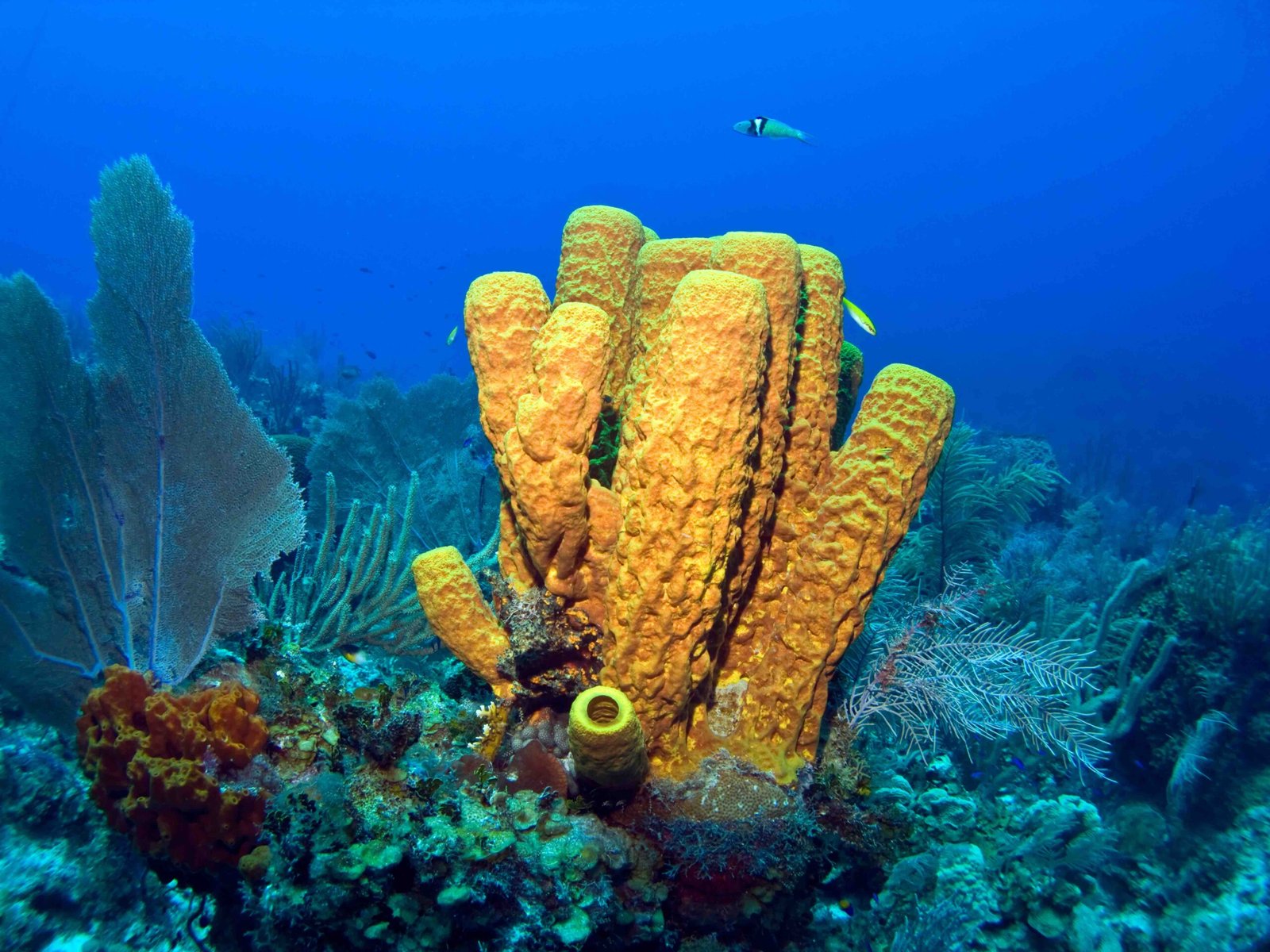Introduction to Sea Sponges
Sea sponges, belonging to the phylum Porifera, represent one of the most primitive forms of animal life on Earth, with a history that extends back more than 600 million years. They are classified into several classes, including Calcarea, Hexactinellida, and Demospongiae, each distinguished by unique skeletal structures and varying habitats. Sponges are primarily found in marine environments, thriving in diverse ecosystems ranging from shallow coastal waters to deep-sea settings.
Physically, sea sponges exhibit a distinctive porous body structure, composed of numerous tiny openings known as ostia. These pores allow water to circulate through the sponge, enabling vital processes such as feeding and respiration. The body of a sponge is held together by a framework of spongin, a fibrous protein, or by silica and calcium carbonate, depending on the type of sponge. This porous system not only facilitates nutrient absorption but also serves as a habitat for various microorganisms, which play integral roles in marine ecosystems.
There are over 8,500 known species of sponges, showcasing a wide range of colors, sizes, and shapes. While many sponges appear as simple, dull forms, others can be vibrantly colored, adding aesthetic beauty to underwater environments. Some notable types include bath sponges, which are commonly harvested for personal care, and glass sponges, recognized for their intricate silica skeletons. Each type of sponge contributes to the overall health of marine life, particularly coral reefs, through their filter-feeding capabilities and the habitats they create. Through this introduction, we begin to appreciate not only the biological features of sea sponges but also their ecological significance, particularly within the fragile balance of coral reef ecosystems.
Top 10 Facts About Sea Sponges
Sea sponges are remarkable organisms that inhabit a variety of marine environments. They belong to the phylum Porifera, which translates to “pore bearer,” highlighting their unique structure characterized by numerous pores and channels that facilitate water filtration. Here are ten fascinating facts about sea sponges that illustrate their importance in aquatic ecosystems.
1. Water Filtration: Sea sponges are among the most efficient natural filters in the ocean. They can filter up to 1500 liters of seawater daily, removing bacteria, microorganisms, and organic particles, enhancing water clarity and quality.
2. Regenerative Abilities: Sponges possess a remarkable capacity for regeneration. They can recover from significant damage, even when broken into smaller pieces, allowing them to reassemble into a functional organism once more.
3. Diverse Habitats: These organisms can be found in various environments, from shallow coastal waters to deep-sea ecosystems. Each species is adapted to its specific habitat, showcasing the evolutionary diversity within the phylum.
4. Biome Indicators: Sea sponges serve as key bioindicators of environmental health. Their sensitivity to changes in water quality makes them valuable for monitoring the health of marine ecosystems.
5. Symbiotic Relationships: Many sponges have symbiotic relationships with microorganisms, such as algae and bacteria. These relationships can enhance nutrient acquisition and provide additional benefits to the sponge.
6. Ancient Organisms: Sponges are some of the Earth’s oldest living creatures, dating back over 600 million years. Their long evolutionary history contributes to their wide array of forms and functions.
7. Minimal Energy Requirements: Sea sponges do not require sunlight, unlike many marine organisms. They thrive in varying light conditions, showcasing their adaptability to different environments.
8. Reproductive Strategies: Sponges employ different reproductive strategies, including asexual reproduction through budding and sexual reproduction, contributing to their resilience and population distribution.
9. Chemical Production: Many sea sponges produce bioactive compounds that have potential pharmaceutical applications, providing a diverse source for drug discovery and development.
10. Ecological Role: Sea sponges contribute significantly to the ecological balance of coral reefs. By filtering water, they help maintain water quality, providing a hospitable environment for a variety of marine life.
Understanding these facts about sea sponges emphasizes their crucial role in marine ecosystems, particularly their benefits to coral reefs and overall ocean health.
Benefits of Sea Sponges to Coral Reefs
Sea sponges play an integral role in supporting coral reefs, providing numerous benefits that contribute to the health and sustainability of these vibrant ecosystems. One of the primary advantages of sea sponges is their function in nutrient cycling. As filter feeders, sponges efficiently filter water by removing bacteria, organic matter, and other particles, thereby enhancing water clarity. This filtering capacity not only promotes a healthier environment for corals but also assists in the removal of excess nutrients that can lead to algal blooms, which threaten coral health.
ecosystems. One of the primary advantages of sea sponges is their function in nutrient cycling. As filter feeders, sponges efficiently filter water by removing bacteria, organic matter, and other particles, thereby enhancing water clarity. This filtering capacity not only promotes a healthier environment for corals but also assists in the removal of excess nutrients that can lead to algal blooms, which threaten coral health.
In addition to nutrient cycling, sea sponges contribute to habitat provision. They create complex structures that offer shelter and protection for various marine species, including fish and invertebrates. This habitat enhancement fosters biodiversity, which is crucial for maintaining balanced coral reef ecosystems. The presence of diverse species can bolster a reef’s resilience to stressors such as climate change and pollution, making it imperative that we protect these sponges as part of our broader conservation efforts.
Another significant benefit of sea sponges lies in their ability to filter and purify seawater. By reducing sedimentation and excess nutrients, sponges help maintain the overall health of coral reefs. Furthermore, the symbiotic relationships that sea sponges form with microorganisms and other marine organisms exemplify their importance within the reef community. These relationships not only enhance nutrient cycling but also contribute to the stability of the ecosystem. As sea sponges interact with algae and bacteria, they create a dynamic environment that supports various life forms, thereby strengthening the resilience of coral reefs against environmental stresses.
Overall, the contributions of sea sponges to coral reef ecosystems are multifaceted, underscoring the vital role they play in fostering biodiversity, enhancing water quality, and sustaining the health of these marine habitats.
Conservation Efforts and the Future of Sea Sponges and Coral Reefs
Sea sponges and coral reefs form essential components of marine ecosystems, yet both face significant challenges exacerbated by human activities. Climate change ranks at the forefront, with rising ocean temperatures contributing to coral bleaching and altering the natural habitats of sponges. Additionally, pollution from land runoff and plastics introduces harmful toxins into marine environments, compromising the health of these organisms and their ecosystems. Habitat destruction, primarily due to coastal development and destructive fishing practices, further threatens the survival of both sea sponges and coral reefs.
In response to these pressing issues, a multitude of conservation efforts have emerged, aiming to protect and restore these vital ecosystems. One prominent initiative is the establishment of marine protected areas (MPAs), which restrict human activities in critical habitats, thereby allowing marine life to thrive. These designated zones serve as refuge for diverse marine species, including sponges and corals, fostering recovery and resilience against external stressors such as pollution and overfishing.
Sustainable fishing practices have also been implemented to minimize damage to coral reef habitats while supporting the livelihoods of coastal communities. By promoting responsible fishing methods, such as selective gear use and catch limits, fish populations can maintain their balance, ultimately benefiting the broader ecosystem, including the interconnected relationships with sea sponges.
The importance of community involvement and education in these conservation efforts cannot be overstated. Raising awareness about the interconnectedness of sea sponges and coral reefs encourages local populations to take active roles in preserving their marine environments. Educational programs and citizen science initiatives aim to foster stewardship, helping individuals understand the necessity of safeguarding these ecosystems for future generations. By combining these collective efforts, we can aspire to ensure the long-term health and sustainability of our underwater worlds.
